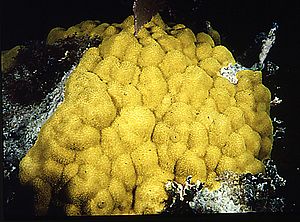Mustard hill coral facts for kids
Quick facts for kids Mustard hill coral |
|
|---|---|
 |
|
| Scientific classification | |
| Synonyms | |
|
The mustard hill coral, also called yellow porites, is a type of colonial stony coral. It belongs to the family called Poritidae. This coral is very common in the Caribbean Sea. You can also find it in the western tropical Atlantic Ocean, near North, Central, and South America. It lives in the eastern tropical Atlantic Ocean too, near western Africa.
Contents
What Does Mustard Hill Coral Look Like?
The mustard hill coral, Porites astreoides, changes its shape depending on where it grows. In shallow water with strong currents, it grows as a thin layer over rocks. In calmer, deeper water, it forms large, smooth, round mounds. These mounds can grow up to 60 centimetres (24 in) wide!
At even greater depths, it often looks like flat plates. In caves or under ledges, these plates angle themselves to catch as much light as possible. This coral is special because it's the only Porites species that doesn't grow in finger-like shapes.
Coral Structure and Color
The coral's surface has many tiny, packed holes. These are called corallites. Each hole is home to a tiny animal called a polyp. Each polyp has six small tentacles. During the day, these tentacles are usually pulled inside.
Mustard hill coral can be yellow, yellowish-green, pale grey, or light brown. Its color comes from tiny algae called dinoflagellate zooxanthellae. These microscopic algae live inside the coral's tissue. They have a special symbiotic relationship, meaning they help each other.
Where Mustard Hill Coral Lives
Porites astreoides is found in shallow waters on coral reefs. It lives in the Caribbean Sea and parts of the Atlantic Ocean. This includes tropical areas of North, Central, and South America. It also lives in tropical western Africa.
You can find this coral in many parts of a reef. It also thrives in calm lagoons. It usually grows in water less than 15 metres (49 ft) deep. Sometimes, it can be found as deep as 50 metres (160 ft).
How it Grows
Sometimes, this coral grows freely on loose pieces of coral. It can also attach to small pebbles or mollusc shells. Large, dome-shaped colonies might look like they are split into several parts. This happens when a section of the coral dies. The living parts around the dead areas keep growing, making it look lumpy.
How Mustard Hill Coral Eats and Reproduces
Feeding Habits
The polyps of Porites astreoides mostly feed at night. They stretch out their tentacles to catch tiny animals called zooplankton. They also eat small bacteria. The coral gets a lot of its food from the zooxanthellae algae too. These algae make food through photosynthesis when the sun shines.
Coral Reproduction and Life Cycle
Some mustard hill coral colonies are female. Others are hermaphroditic, meaning they have both male and female parts. Sexual reproduction happens when male cells are released into the sea. This usually occurs around the new moon.
These male cells are drawn into other polyps, where fertilization takes place. The baby corals, called larvae, are kept safe inside the parent for a while. They are then released into the sea around the full moon. These tiny planula larvae float with the ocean currents. Eventually, they settle onto the seabed. There, they change into new polyps. Each new polyp then grows into a new coral colony. It does this by making a hard calcareous skeleton and by budding.
Mustard Hill Coral in its Environment
Porites astreoides often has a sponge called Mycale laevis growing underneath it. This sponge has noticeable holes called osculi. This coral is also often found with fan worms.
Protection and Growth
The coral's polyps have stinging cells called nematocysts. These cells help protect the coral from animals that want to eat it. These predators include the stoplight parrotfish, other reef fish, snails, worms, and starfish.
It's important for the coral to be in a sunny spot. This allows its zooxanthellae to make enough food. Too much sediment can block the light. But in good conditions, this coral can grow about 3.5 millimetres (0.14 in) each year.
Conservation Status
The IUCN Red List of Threatened Species says this coral is of "least concern". This means it is not currently at high risk of disappearing. It is common and found in many places. Compared to other corals, it is strong against diseases and bleaching. It also lives in deeper water, which might protect it from rising sea temperatures.

